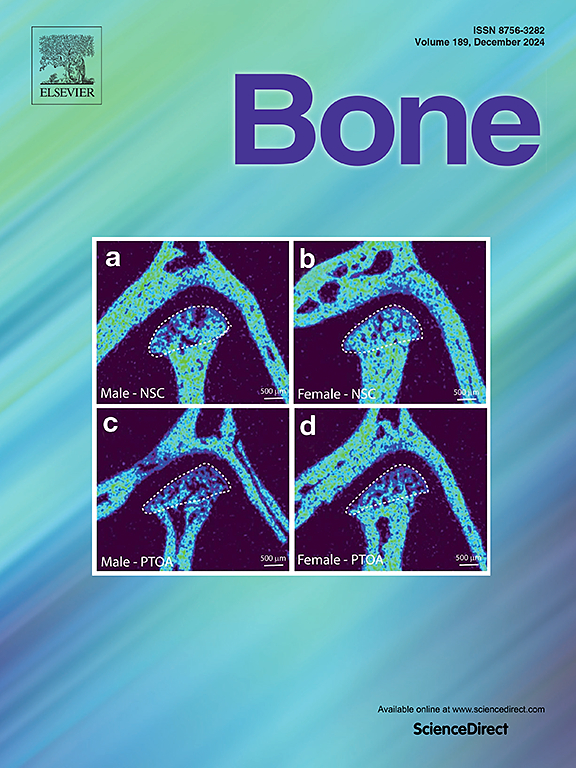denosumab对骨重塑的有效抑制并不会减弱小鼠对romosozumab的合成代谢反应
IF 3.6
2区 医学
Q2 ENDOCRINOLOGY & METABOLISM
引用次数: 0
摘要
组织学分析表明,抑制硬化蛋白增加骨量主要是通过刺激基于模型的骨形成。然而,临床研究表明,抑制骨重塑的抗骨吸收疗法会减弱抗硬化蛋白抗体romosozumab的合成代谢作用。此外,抑制重塑可抑制sost缺乏小鼠的骨形成。这些后一项研究表明,骨重塑是抑制硬化蛋白完全合成代谢作用所必需的。为了解决这个问题,我们使用抗rankl抗体denosumab抑制小鼠骨重塑,然后给予romosozumab,以及持续的denosumab。对照组接受单独的denosumab或单独的romosozumab治疗。denosumab并没有减弱romosozumab诱导的骨质增加。同样地,denosumab不改变romosozumab诱导的成骨细胞数量和骨形成的增加。在停用denosumab引起的反弹吸收小鼠模型中,romosozumab的合成代谢作用也没有改变。尽管如此,denosumab减少了sost缺乏小鼠的骨形成。这些结果表明,在硬蛋白抑制与Sost基因失活的合成代谢作用中,对骨重塑的依赖存在显著差异,并表明在这两种情况下,不同的机制驱动成骨细胞的产生。此外,他们认为临床研究中对romosozumab的迟钝反应不是由于抑制重塑。本文章由计算机程序翻译,如有差异,请以英文原文为准。
Potent suppression of bone remodeling by denosumab does not blunt the anabolic response to romosozumab in mice
Histological analyses suggest that sclerostin inhibition increases bone mass primarily by stimulating modeling-based bone formation. However, clinical studies show that anti-resorptive therapies, which inhibit bone remodeling, blunt the anabolic effect of the anti-sclerostin antibody romosozumab. Moreover, suppressing remodeling inhibits bone formation in Sost-deficient mice. These latter studies suggest that bone remodeling is required for the full anabolic effect of sclerostin suppression. To address this, we suppressed bone remodeling in mice using the anti-RANKL antibody denosumab and then administered romosozumab, along with continued denosumab. Controls received either vehicle, denosumab alone, or romosozumab alone. The romosozumab-induced increase in bone was not blunted by denosumab. Similarly, the romosozumab-induced increases in osteoblast number and bone formation were not altered by denosumab. The anabolic effect of romosozumab was also not altered in a mouse model of rebound resorption caused by denosumab discontinuation. Nonetheless, denosumab reduced bone formation in Sost-deficient mice. These results demonstrate a striking difference in the dependence on bone remodeling for the anabolic effects of sclerostin suppression versus genetic inactivation of Sost and suggest distinct mechanisms drive osteoblast production in the two conditions. In addition, they suggest that the blunted response to romosozumab in clinical studies is not due to suppressed remodeling.
求助全文
通过发布文献求助,成功后即可免费获取论文全文。
去求助
来源期刊

Bone
医学-内分泌学与代谢
CiteScore
8.90
自引率
4.90%
发文量
264
审稿时长
30 days
期刊介绍:
BONE is an interdisciplinary forum for the rapid publication of original articles and reviews on basic, translational, and clinical aspects of bone and mineral metabolism. The Journal also encourages submissions related to interactions of bone with other organ systems, including cartilage, endocrine, muscle, fat, neural, vascular, gastrointestinal, hematopoietic, and immune systems. Particular attention is placed on the application of experimental studies to clinical practice.
 求助内容:
求助内容: 应助结果提醒方式:
应助结果提醒方式:


